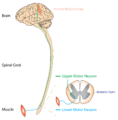Motor neurone disease facts for kids
Motor neurone disease (MND) is a serious illness that affects the nerve cells controlling your muscles. These nerve cells are called motor neurons. They send messages from your brain to your muscles, telling them to move. This helps you do things like walk, talk, swallow, and even breathe.
MND is a long-lasting disease that gets worse over time. It slowly damages and kills these important motor neurons. When the motor neurons die, they can no longer send messages to the muscles. This causes the muscles to become weak and waste away. Eventually, people with MND lose the ability to control their voluntary movements. This means they can't move their arms, legs, or even the muscles needed for speaking and swallowing.
There is currently no cure for motor neurone disease. It is a very rare condition. Most people who get MND are between 40 and 60 years old. Even though the body's muscles are affected, a person's intelligence, memory, and personality usually stay the same.
Contents
What is ALS?
The most common type of motor neurone disease is called Amyotrophic lateral sclerosis (ALS). It is also known as Lou Gehrig’s disease, named after a famous baseball player who had it. About 5 to 10 out of every 100 cases of ALS are inherited from a parent.
How Does MND Affect the Body?
MND causes muscles all over the body to become weak and shrink. This happens because both the upper motor neurons (in the brain) and the lower motor neurons (in the spinal cord) stop working. When these nerve cells can't send messages, the muscles don't get the signals they need to move. Over time, the muscles become weaker and weaker.
What are the Signs of MND?
It can be hard to tell if someone has motor neurone disease at first because the early signs are not always clear.
Early Signs of MND
The first signs of MND can be:
- Muscle twitching or cramping.
- Muscles feeling stiff.
- Weakness in an arm or a leg.
- Speech that sounds slurred or strange.
- Trouble chewing or swallowing food.
These early signs can slowly turn into more noticeable weakness or shrinking of muscles. This might make a doctor think that a person has ALS.
How MND Starts in Different People
MND can start in different parts of the body.
Limb Onset ALS
About 75 out of 100 people with ALS first notice symptoms in their arms or legs. This is called "limb onset" ALS.
- Some people might first feel awkward when walking or running. They might trip or stumble more often.
- Others might first notice problems with their hands or arms. They might find it hard to do simple tasks that need fine hand movements. This includes things like buttoning a shirt, writing, or turning a key in a lock.
Bulbar Onset ALS
About 25 out of 100 people with ALS first have problems with speaking or swallowing. This is called "bulbar onset" ALS.
- Their speech might become hard to understand and sound slurred.
- They might speak through their nose or talk more softly.
- Later, they might have trouble swallowing food or drinks.
- They might also lose the ability to move their tongue well.
- Eventually, they may completely lose the ability to speak and keep their airway clear when swallowing.
Is There a Treatment for MND?
There is no cure for ALS right now. However, there are treatments that can help manage the symptoms and improve a person's quality of life.
Medications for MND
The Food and Drug Administration (FDA) has approved the first medicine for ALS called Riluzole (Rilutek).
- Doctors believe Riluzole helps protect motor neurons from further damage.
- Studies have shown that Riluzole can help people with ALS live longer by several months. This is especially true for those who have trouble swallowing.
- The medicine can also delay the time before a person needs help with breathing.
- It's important to know that Riluzole does not fix the damage that has already happened to the motor neurons. But it gives hope that future medicines might be able to slow down ALS even more.
Other Ways to Help
Besides medication, other treatments focus on making symptoms less painful. They also aim to help people with MND live as comfortably as possible. These treatments can include:
- Physical therapy to help with movement.
- Occupational therapy to help with daily tasks.
- Speech therapy to help with speaking and swallowing.
- Special equipment to help with breathing or communication.
Images for kids
-
The French neurologist Jean-Martin Charcot coined the term amyotrophic lateral sclerosis in 1874.
See also
 In Spanish: Esclerosis lateral amiotrófica para niños
In Spanish: Esclerosis lateral amiotrófica para niños








